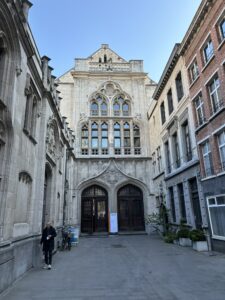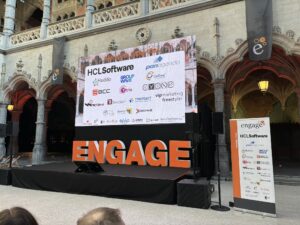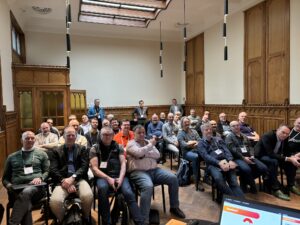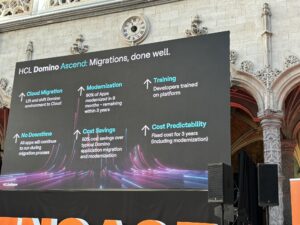My thoughts on Engage 2024

Last week was the HCL user group event Engage in Antwerp, Belgium. It’s one of my favourite events. It’s meticulously organized by Theo Heselmans, who this year organized Engage and its predecessor, BLUG, for the 15th time. As he announced last year in Amsterdam, it was also the last time that he would organize this event, and it’s therefore logical that this fact played an important role during the event. Both in the opening session, where Theo announced his successors (Kris de Bisschop and Tom van Aken), in the keynote from HCL where they transformed their theme, the community, into Theo, in the emotional closing session where Theo received nice gifts from HCL and the HCL Ambassadors and in the attendants. I spoke to quite a few people who told me that Theo’s upcoming retirement as Engage’s organizer played a major role in their decision to make the trip (from all around the world).

That brings me to what for me is the main reason to love this event: The community. The reality of our world is that the amount of people who are administering or developing in the HCL products within a single company is usually limited to just a small group of people or even a single person. That means that we often depend on the community to help each other when we’re facing problems, and a community functions better when you regularly meet each other in real life.
But of course a conference is about more than just catching up with the people who you otherwise only speak online. There were more than 70 sessions in 2 days and a lot of them were interesting. As most of my work hours are currently spent on running HCL DX and HCL Leap on OpenShift, a lot of my attention went to those sessions.
HCL DX and HCL Leap
New this year was that you could actually fill your session agenda with those 2 products. In the past HCL DX and Leap played a minor role at Engage. Their larger role this year went on the expense of HCL Connections, which was basically invisible during Engage, though Connection is developed in the same team as HCL DX.
On Monday, I joined a workshop about HCL Leap. Though my daily job involves the roll-out of Leap, it doesn’t involve the use of Leap, so I was surprised to see how much Leap has evolved in the past years. The change of names (Forms Experience Builder => Volt => Leap) was accompanied by serious investments in the product. During the workshop, I experienced how easy it is these days to create great looking forms with HCL Leap. We used HCL Leap during the workshop, but the differences with HCL Domino Leap are very small these days and are mainly around things like mail and Domino directory integration, which of course is very easy to accomplish when using Domino.
On Tuesday, I attended a session from a Development team of Dutch Tax Office (my current assignment is also with DTO) where they showed the new Leap functionality, added in the past year: Custom widgets. They’ve created custom widgets for all kinds of components using their own design system, which gives each component the look of the Dutch Tax Office. Business teams consisting of non-IT users are using these widgets to convert 500+ paper forms to electronic forms and are successful doing so. Custom widgets seem like a very powerful addition to the HCL Leap product.
Leap is the first WebSphere based product where HCL managed to get rid of the IBM technology. They already did 2 years ago that with Domino Leap, but last year they also managed to replace WebSphere by OpenLiberty and added PostgreSQL as backend database, removing the need for DB2. HCL is also attempting the same for HCL DX, but this project faces some delays. Where originally we would see a beta of HCL DX on OpenLiberty around Q3, this is now scheduled for the end of this year. The first priority for the next few months, is fixing numerous accessibility issues which were identified in HCL DX and HCL Leap.
My own Session – Domino containers – The Next Step

At 8 o’clock on Wednesday morning, I presented my own session at Engage: Domino Containers – The Next Step. In this session, I gave an update of what has happened in the past two years in the Domino Container community project. The early morning sessions are usually not well visited (I often miss them myself if I don’t have to present), so I felt honoured to have a full house. Part of my presentation was a live demo, which is always risky. I started with a completely fresh minimal Rocky Linux 9 installation and I promised my audience that half an hour into my presentation, they would see a running Domino server with Verse, Traveler, the Domino REST api, the C-API SDK and Leap all installed. I started my demo around 08:15, so in 15 minutes I would go from zero to a full fledged running Domino server including downloading all the software. I would have made it, had I not been hit by a problem with the default CentOS 9 Stream base image, which couldn’t find any mirrors for that project. That did allow me to show the audience how easy it is to switch to a different base image and about 7 minutes after the promised time, I had my full fledged Domino server running. I even still got to my last presentation slide right at the end of my time slot.
The problem with CentOS 9 Stream happened for the 2nd time within a month (the 2nd time of about 10 times that I built the demo container), and for Daniel and me that was enough reason to replace it with RedHat’s minimal Universal Base Image as the new default. We want to give users of the project the most reliable experience possible.
These were the slides of my presentation. This session was only 45 minutes, but in September, Daniel Nashed and I will do a rerun during an OpenNTF webinar, where we’ll have about 30 minutes extra.
Other impressions

I managed to miss many of the roadmap sessions, so I can’t say much about the announcements that HCL made during Engage. One of the announcements they made during the opening session was Domino Ascend. This is an HCL initiative where they help you move the user interface of your application to HCL Volt MX Go while the data remains in Domino. Volt MX Go will allow you to re-use all the code from Domino agents, script libraries etc, which makes these types of migrations a lot easier. There were many sessions around HCL Volt MX and HCL Volt MX Go, but as I didn’t attend those, I don’t know what was discussed.
Though Volt MX might play a big role in HCL’s plans for the future, the average attendant still lives and breathes Domino. The attendance of the Domino related sessions far exceeded the attendance of other HCL products. Many developers are sniffing at HCL Volt MX, but their daily work is around HCL Domino. It shows that Domino is still very much alive.

